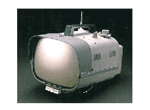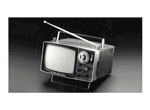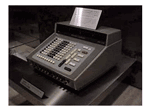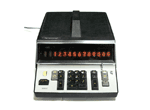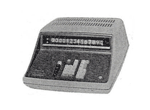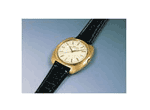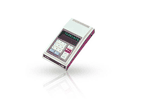Application Products
1960s
1960: Transistor-based black-and-white TV (Sony)
Sony had been developing portable TVs and released an 8-inch black-and-white TV, the TV8-301, in May 1960. The TV8-301 had 23 transistors (of both silicon and germanium), 19 diodes, and two compact rectifying vacuum tubes. Furthermore, nine of the transistors used for horizontal deflection, video output, and tuning were newly developed.
1962: Five-inch Micro TV is a huge hit (Sony)
Sony released a 5-inch Micro TV, the TV5-303. This was more compact and achieved higher performance than the TV8-301. The TV5-303 took the U.S. by storm as soon as it was officially released in Sony’s newly opened showroom in New York on October 1st, 1962.
March, 1964: Japan’s first electronic desktop calculator (Sharp)
Sharp (Hayakawa Electric at the time) released its first desktop calculator, the CS-10A, in March 1964. This was not only Japan’s first desktop calculator but also the first all-transistor desktop calculator in the world.
The CS-10A cost 535,000 yen, enough to buy a car at the time, and weighed 25 kg. 530 transistors and 2,300 diodes were used in each calculator.
1966: World’s first IC-based calculator (Sharp)
Sharp preceded its competitors in the development of calculators using ICs. Sharp added improvements to their first calculator, the CS-10A released in 1964, to make a new keypad-type calculator, the CS-20A.
The company also developed the CS-31A, the world’s first calculator to employ a bipolar IC, in 1966. This was followed by the development of the CS-16A, using MOS ICs, in 1967.
1967: World’s first IC-based radio (Sony)
The world’s first IC-based radio, the ICR-100, incorporated the CX-001 IC, which contained 14 transistors, four diodes, and 14 resistors.
The ICR-100 was almost as small as a matchbox and remarkably light (weighing only 90 g). It also contained a rechargeable nickel–cadmium battery.
Charging the battery for 14 hours made the ICR-100 usable for approximately six hours.
1969: World’s first all-transistor color TV (Hitachi)
Hitachi succeeded in taking a 19-inch all-transistor color TV, the CF-570TU, to mass production.
This marked the beginning of the application of all-transistor designs in all subsequent color TVs. With its nickname “Pompa”, referring to how the image pops up on the screen as soon as the power is turned on due to preheating of the cathode-ray tube while the power is off, the CF-570TU became a smash hit.
1969: World’s first electronic quartz wristwatch Astron (Seiko)
Seiko released the world’s first quartz wristwatch, the Astron (35SQ), which incorporated a crystal resonator, a special-purpose IC for watches, and a stepping motor.
Considering that the mechanical watches of the time had an average error of 20 seconds a day, the Astron was extraordinarily accurate: 5 seconds per month and 0.2 seconds per day.
The oscillating circuit, dividing circuit, and driving circuit were integrated into a single hybrid IC, which was made by manually soldering 76 transistors, 29 capacitors, and other parts to a ceramic board.
1969: World’s first LSI-based electronic calculator, the Micro Compet QT-8D (Sharp)
Although Sharp aimed to develop more compact and less expensive electronic calculators using MOS LSIs, most IC manufacturers were not accepting Sharp’s requests for supplies of MOS LSIs. Only Rockwell in the U.S. responded, making a contract with Sharp for the supply of three million LSIs for $30 million. In 1969, Sharp successfully produced the world’s first LSI-based electronic calculator, the QT-8D. The commercial success of the QT-8D brought enormous profits to both Sharp and Rockwell.


